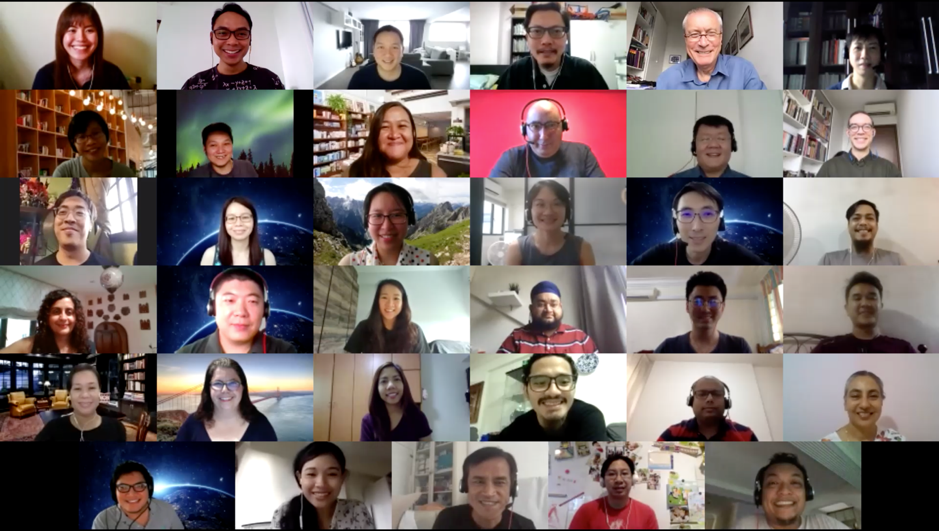Excellence and Adaptability – Teaching and Learning amid the COVID-19 pandemic
 Students from all across the globe connect via Zoom for virtual seminars. Image provided by Akanksha Madan.
Students from all across the globe connect via Zoom for virtual seminars. Image provided by Akanksha Madan.
As a residential community where living and learning intertwine, the COVID-19 pandemic challenged the educational model offered at Yale-NUS College. Despite the unprecedented hurdles faced by faculty, staff, and students over the past few months, the community has remained steadfast in its commitment to teaching and learning.
The College has been quick to respond to changing demands as the pandemic evolved. All classes with over 50 students, such as the Common Curriculum lectures attended by the entire first-year cohort, were shifted online in February 2020. Students were also offered the option to transition to distance learning if preferred, such as attending virtual lessons.
By the first week of April, Yale-NUS had completely transitioned to online learning before the Singapore government implemented a set of preventive measures collectively called ‘circuit breaker’ measures to stem the community spread of COVID-19 infections.
The Yale-NUS Centre for Teaching and Learning (CTL), in particular, has been aiding faculty with teaching considerations for online learning, such as promoting student discussions, appropriate online assessment methodologies, and maintaining academic integrity. During this unusual period, the CTL’s support is built upon the understanding that the community is navigating a crisis.
“This means we need to consider scaling down our expectations for our students, and even for ourselves. It also means prioritising a sense of connection and community with our classes,” said Interim Director of the Centre for Teaching and Learning, and Senior Lecturer for Social Sciences (Global Affairs) Dr Catherine Sanger.
A Senior Lecturer herself, Dr Sanger prioritised ensuring that her classes were a safe space for intellectual stimulation and not a cause of emotional stress for her students. This has meant making some hard choices about adjusting content in her curriculum while still enabling students to gain valuable insights and have a sense of achievement.
Drawing from the CTL’s guidance, faculty members are making similar considerations. “I particularly enjoyed Dr Catherine Sanger’s article, exhorting faculty to focus primarily on educational aims instead of becoming consumed by policing or mandating student behaviour,” said Assistant Professor of Social Sciences (Psychology) Christopher L Asplund.
The Educational Resources & Technology (ERT) Department has been providing key support for these flexible and agile responses to the challenges introduced by COVID-19. To support the changing teaching and learning priorities, all pillars of ERT have been tirelessly working in synchronisation.
“Our priorities during the COVID-19 period have been to try to anticipate and adapt quickly to each stage of the restrictions under the circuit breaker, providing as full a service as possible under the circumstances, even with staff working from home,” said Dean of Educational Resources & Technology Mr Ronald Milne.
 Due to the circuit breaker measures, the Educational Resources & Technology (ERT) team meet via Zoom. Image provided by Dean Milne.
Due to the circuit breaker measures, the Educational Resources & Technology (ERT) team meet via Zoom. Image provided by Dean Milne.
With the shift to online learning, ERT immediately acquired Zoom licenses and integrated the video-conferencing application with the College’s learning management platform Canvas. Zoom is primarily used for seminars, a hallmark of Yale-NUS where teaching is typically conducted in groups of fewer than 20 students. Faculty who were used to writing on whiteboards were introduced to tablets and stylus. In addition, lectures, where professors teach more than 50 students, were live-streamed.
Acknowledging that the shift to remote teaching could have varying challenges for faculty members, ERT conducted training sessions.
“The main idea was simple: Provide a ‘blanket’ induction training to all, then let the faculty decide how they would want to conduct their first online lessons as a start. Just like reading a physical book and then getting accustomed to reading e-books on a device, we need to get them [faculty] used to virtual environments first,” said Senior Manager of Media & Communication Technology Mr Eddie Ong, and Senior Education Technologist Mr Muhammad Husaini.
Behind the scenes of a seamless shift to online teaching, ERT had to overcome multiple challenges. Having to divide staff strength into half and work in rosters on alternate weeks due to government regulations, the team was forced to work below maximum capacity to provide an increased set of services to the community. At the same time, they had to continue attending to other critical operations, like ensuring course evaluations, capstone project submissions, and grading proceed smoothly. As a result, the team has worked long hours this semester to ensure that the College’s new teaching model could be achieved.
These efforts to support the academic community have paid off. Faculty members have been adapting the use of Zoom to fit their teaching and student engagement needs. For instance, many have employed Zoom’s breakout rooms feature, which allows for meetings to divide into smaller sections, replicating the intimate group discussions commonly used in seminars.
As the College prepares for contingencies and its next academic year, faculty members are exploring how to enhance the online learning experience. In addition to breakout rooms, Visiting Senior Fellow for Humanities (English Literature) Professor Jane Baron Nardin plans to split each class into two groups and meet them separately over Zoom to maintain the quality of discussion. “I’ll try to do a lot with individual writing, via discussion threads on Canvas and innovative short writing assignments. Maybe having students respond to one another’s responses might be a good substitute for face-to-face discussion,” she added.
ERT continues to help faculty members maximise the potential of online learning. “There has to be more than simply pointing a laptop camera and speaking. How do we translate an experience or lesson online? Choreography or lectures need to be ‘trans-created’ to maximise the possibilities of a new format,” said Senior Associate Director of ERT Arts Mr Gurjeet Singh.
To learn more about Yale-NUS’ commitment to teaching during COVID-19, visit https://www.yale-nus.edu.sg/academics/overview/learning-and-teaching-resources/distance-teaching-and-learning-resources/.





